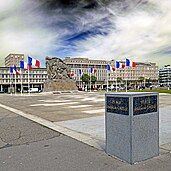
Back Le Havre Afrikaans Le Havre AN لو هافر Arabic لو هافر ARZ Le Havre AST Havr Azerbaijani لو آور AZB Гавр Bashkir Le Havre BAN Гаўр Byelorussian
Le Havre
Lé Hâvre (Norman) | |
|---|---|
Subprefecture and commune | |
|
| |
| Coordinates: 49°29′N 0°06′E / 49.49°N 0.10°E | |
| Country | France |
| Region | Normandy |
| Department | Seine-Maritime |
| Arrondissement | Le Havre |
| Canton | Le Havre-1, 2, 3, 4, 5 and 6 |
| Intercommunality | Le Havre Seine Métropole |
| Government | |
| • Mayor (2020–2026) | Édouard Philippe[1][2] (Horizons) |
| Area 1 | 46.95 km2 (18.13 sq mi) |
| • Urban (2018) | 194.9 km2 (75.3 sq mi) |
| • Metro (2018) | 995.8 km2 (384.5 sq mi) |
| Population (2021)[3] | 166,058 |
| • Rank | 15th in France |
| • Density | 3,500/km2 (9,200/sq mi) |
| • Urban (2018[4]) | 234,945 |
| • Urban density | 1,200/km2 (3,100/sq mi) |
| • Metro (2018[4]) | 337,086 |
| • Metro density | 340/km2 (880/sq mi) |
| Time zone | UTC+01:00 (CET) |
| • Summer (DST) | UTC+02:00 (CEST) |
| INSEE/Postal code | 76351 /76600, 76610, 76620 |
| Website | www.lehavre.fr |
 | |
| Official name | Le Havre, the City Rebuilt by Auguste Perret |
| Criteria | Cultural: ii, iv |
| Reference | 1181 |
| Inscription | 2005 (29th Session) |
| Area | 133 ha |
| Buffer zone | 114 ha |
| 1 French Land Register data, which excludes lakes, ponds, glaciers > 1 km2 (0.386 sq mi or 247 acres) and river estuaries. | |
Le Havre (/lə ˈhɑːv(rə)/ lə HAHV(-rə),[5][6][7] French: [lə ɑvʁ(ə)] ; Norman: Lé Hâvre [lɛ ˈhɑvʁ(ə)]) is a major port city in the Seine-Maritime department in the Normandy region of northern France. It is situated on the right bank of the estuary of the river Seine on the Channel southwest of the Pays de Caux, very close to the Prime Meridian. Le Havre is the most populous commune of Upper Normandy, although the total population of the greater Le Havre conurbation is smaller than that of Rouen. After Reims, it is also the second largest subprefecture in France. The name Le Havre means "the harbour" or "the port". Its inhabitants are known as Havrais or Havraises.[8]
The city and port were founded by King Francis I in 1517. Economic development in the early modern period was hampered by religious wars, conflicts with the English, epidemics, and storms. It was from the end of the 18th century that Le Havre started growing and the port took off first with the slave trade then other international trade. After the 1944 bombings the firm of Auguste Perret began to rebuild the city in concrete. The oil, chemical, and automotive industries were dynamic during the Trente Glorieuses (postwar boom) but the 1970s marked the end of the golden age of ocean liners and the beginning of the economic crisis: the population declined, unemployment increased and remains at a high level today.
Changes in years 1990–2000 were numerous. The right won the municipal elections and committed the city to the path of reconversion, seeking to develop the service sector and new industries (aeronautics, wind turbines). The Port 2000 project increased the container capacity to compete with ports of northern Europe, transformed the southern districts of the city, and ocean liners returned. Modern Le Havre remains deeply influenced by its employment and maritime traditions. Its port is the second largest in France, after that of Marseille, for total traffic, and the largest French container port.
In 2005, UNESCO inscribed the central city of Le Havre as a World Heritage Site because of its unique post-WWII reconstruction and architecture.[9] The André Malraux Modern Art Museum is the second of France for the number of impressionist paintings. The city has been awarded two flowers by the National Council of Towns and Villages in Bloom in the Competition of Cities and Villages in Bloom.[10]
- ^ "Elections municipales 2020 : Edouard Philippe est officiellement réélu maire du Havre". Franceinfo. 5 July 2020.
- ^ "Répertoire national des élus: les maires" (in French). data.gouv.fr, Plateforme ouverte des données publiques françaises. 30 November 2023.
- ^ "Populations légales 2021". The National Institute of Statistics and Economic Studies. 28 December 2023.
- ^ a b Cite error: The named reference
insee2018was invoked but never defined (see the help page). - ^ "Le Havre". The American Heritage Dictionary of the English Language (5th ed.). HarperCollins. Retrieved 21 July 2019.
- ^ "Le Havre". Lexico UK English Dictionary. Oxford University Press. Archived from the original on 18 July 2022.
- ^ "Le Havre". Merriam-Webster.com Dictionary. Retrieved 21 July 2019.
- ^ "Le nom des habitants du 76 - Seine-Maritime". Habitants.
- ^ "Le Havre, the City Rebuilt by Auguste Perret". UNESCO World Heritage Centre. United Nations Educational, Scientific, and Cultural Organization. Retrieved 13 November 2021.
- ^ "Site officiel du Label Villes et Villages Fleuris". www.villes-et-villages-fleuris.com. Archived from the original on 10 December 2014.
© MMXXIII Rich X Search. We shall prevail. All rights reserved. Rich X Search










